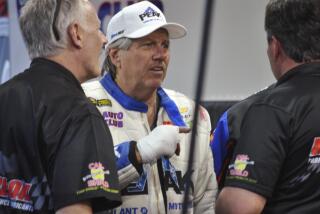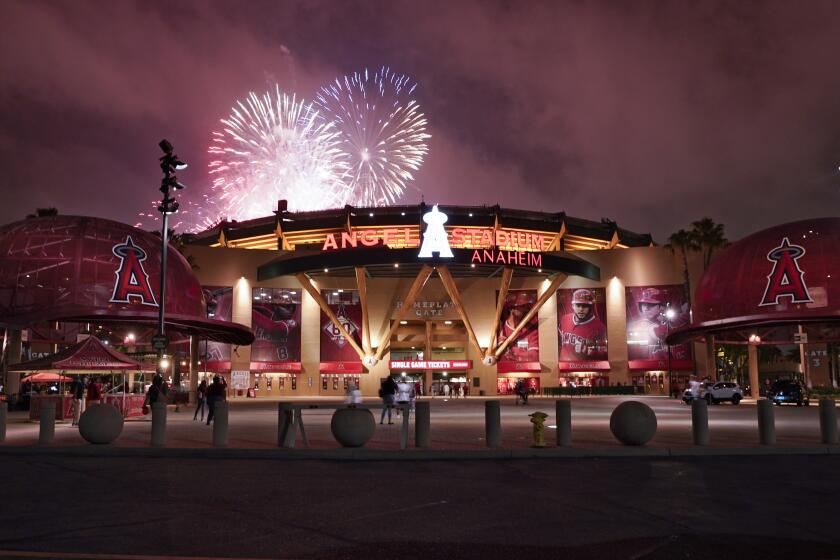Racing Legend Dale Earnhardt Dies at Daytona
- Share via
DAYTONA BEACH, Fla. — Dale Earnhardt, America’s greatest active stock car driver, was killed Sunday on the final turn of the final lap of the Daytona 500 when his Chevrolet Monte Carlo crashed almost head-on into a concrete retaining wall at Daytona International Speedway.
Earnhardt, 49, seven times a Winston Cup champion and winner of the 1998 Daytona 500, was racing for third position on the fourth turn of the 2.5-mile, D-shaped track when his car was tapped in the rear by Sterling Marlin’s Dodge. Earnhardt then lost control on the 31-degree banking, his car turned abruptly and headed at about a 75-degree angle for the wall, where it was struck by Ken Schrader’s Pontiac as it hit the wall.
Schrader was not injured.
In an ironic twist, the race was won by one of Earnhardt’s team drivers, Michael Waltrip, and Earnhardt’s son, Dale Jr., was second. A crowd estimated at more than 200,000 watched the opening race of the 2001 NASCAR Winston Cup season, the premier event in stock car racing.
Dr. Steve Bohannon, director of emergency medical services at the track, said Earnhardt was unconscious and had no palpable pulse when paramedics arrived. Firefighters had to cut away the roof of Earnhardt’s car to get him out. He was flown to nearby Halifax Medical Center but “he never showed any signs of life,” Bohannon said.
Earnhardt was pronounced dead at 5:16 p.m. EST. His wife, Teresa, was at his bedside.
Earnhardt, who would have been 50 on April 29, was a throwback, the kind of rough-and-tumble driver who would have been perfectly at home in the early days of stock car racing, when some of its best drivers were former moonshiners who had learned to race by out-driving revenue agents on dark country roads.
Known as “the Intimidator”--he liked to bump slower cars out of his way--he won 76 Winston Cup races, first among active drivers and sixth all time, and more than $40 million in his 27-year career. Daytona was his favorite track. He had won 34 races here, climaxed by his 1998 victory in the 500, which until then had been his jinx race. He had not won it in 19 previous tries. Otherwise, he had won at least one race on the track every year since 1989.
After failing to win earlier in the week at Daytona in the Budweiser Shootout, his 125-mile qualifying race and the International Race of Champions, he said Saturday, “I’ve got one shot left, maybe it’s a good omen for the 500.”
Earnhardt drove for car owner Richard Childress but also presided over a multimillion-dollar corporation, Dale Earnhardt Inc., that included a three-car Winston Cup team composed of drivers Waltrip, Dale Jr. and Steve Park.
He grew up watching his father, Ralph Earnhardt, drive on NASCAR’s late-model sportsman series, and racing was his life. He was the most prominent driver killed in a race since Ayrton Senna, a Brazilian considered one of Formula One’s greatest drivers, died at Imola, Italy, in 1994.
The news of Earnhardt’s death muted the celebration of Waltrip’s victory, his first in 463 Winston Cup races.
“Today NASCAR lost its greatest driver in the history of the sport,” said Bill France, NASCAR chairman of the board. “And I lost a dear friend.”
In the winner’s circle, not aware of Earnhardt’s death, Waltrip said, “I was just so looking forward to doing well for him, and then he wasn’t there in Victory Lane and I didn’t know that he was hurt. This would all be a dream if it weren’t for Dale Earnhardt.”
Waltrip, younger brother of three-time champion Darrell Waltrip, was hired by Earnhardt to drive his No. 15 car in September.
NASCAR was still recovering from three fatalities last season. Adam Petty, the fourth-generation driver of racing’s legendary Petty family, and Kenny Irwin Jr. were killed while practicing less than two months apart at New Hampshire International Speedway in Loudon, N.H. Tony Roper was killed at Texas Motor Speedway in a NASCAR Craftsman Truck race.
All three died of head injuries. After fatal injuries in their series, other racing sanctioning bodies, such as Formula One and Championship Auto Racing Teams mandated use of a head-and-neck support device designed to protect the head at sudden impact. However, NASCAR did not require its use, and only a few drivers in Sunday’s race were wearing one. Earnhardt was not one of them.
“There will be an autopsy tomorrow, but I am certain it will reveal death occurred from head injuries, particularly at the base of the skull,” Bohannon said.
“I don’t know if [the head-restraint device] would have saved his life or not. That would be pure speculation at this point. I know a full-face helmet would not have made any difference whatsoever. He had no evidence of facial injuries.”
After last year’s Daytona 500, Earnhardt and others criticized NASCAR for its restrictor-plate rule that brought speeds down dramatically.
A new aerodynamic package, designed to slow the cars from speeds approaching 200 mph, had been designed for two tracks, Daytona and Talladega (Ala.) Superspeedway.
When two 125-mile qualifying races Thursday at Daytona provided exciting races, Earnhardt praised the changes and said fans would have more excitement to look forward to in Sunday’s 500.
All week long, however, many other drivers said they feared “the Big One,” meaning a multi-car wreck while packs of a dozen or more cars were running side by side at 190 mph.
It seemed their worst fears were realized when Robby Gordon tapped wheels with Ward Burton on the 175th lap of the 200-lap race and triggered a 21-car wreck that had Daytona’s backstretch looking like a junkyard. Nine cars were knocked out of the race.
Despite the widespread damage to cars, only one driver, Tony Stewart, was injured. Stewart’s car became airborne and flipped four times, landing on top of teammate Bobby Labonte’s car before flopping back on all four wheels.
Stewart was hospitalized with a concussion and bruised shoulder but was released later in the day.
There were 49 lead changes among 14 drivers and, until Earnhardt’s wreck, most observers were calling Sunday’s race one of the best in years.
More to Read
Go beyond the scoreboard
Get the latest on L.A.'s teams in the daily Sports Report newsletter.
You may occasionally receive promotional content from the Los Angeles Times.










